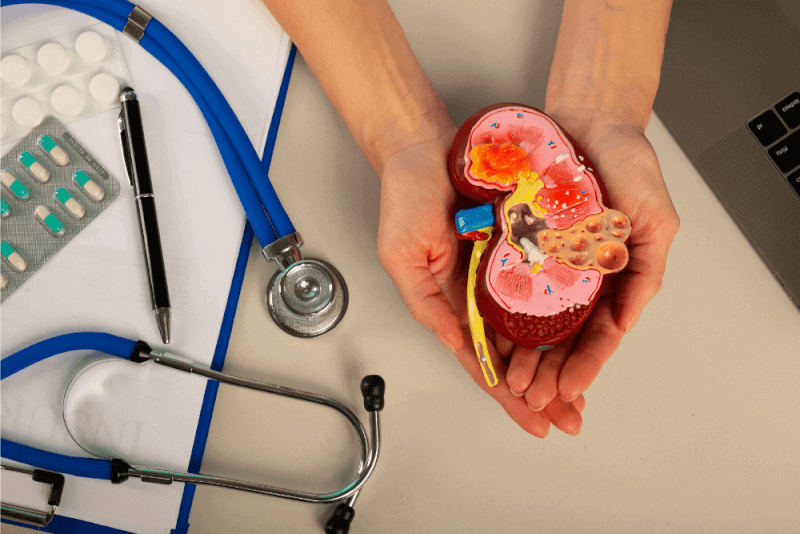What is Wilms Tumor (Nephroblastoma)?
Wilms tumor is a type of cancer that primarily affects children. This rare cancer is also known as nephroblastoma.
Wilms tumor is the most common type of kidney cancer in children, typically affecting those between the ages of 3 and 4. It can occasionally affect children older than 5, and rarely, it can also affect older children and adults.
Wilms tumor usually occurs in one kidney, but in some cases, it can affect both kidneys simultaneously. The prognosis for children with this tumor has significantly improved thanks to the treatments available.
Diagnosis Methods for Wilms Tumor (Nephroblastoma)
Diagnosis begins with a family history and various tests. Before starting these tests, specialists will conduct a physical examination and look for possible symptoms. Additionally, blood and urine tests are requested to understand how well the kidneys are functioning.
Finally, various imaging tests are used to create images of the kidneys to determine if a kidney tumor is present. These imaging tests include ultrasound, CT scans, MRI, and chest X-rays.
In some cases, especially when planning complex operations, 3D printers are used to create a complete model of the patient's body to aid in surgery.
Causes of Wilms Tumor (Nephroblastoma)
The development of tumor cells starts with changes in their DNA. However, the specific changes and reasons for Wilms tumor occurrence are not well understood.
In Wilms tumor, these DNA changes occur in the kidney cells, leading to the formation of extra cells. Although rare, DNA changes inherited from parents can increase the risk of developing Wilms tumor.
Risk Factors for Wilms Tumor
Factors that can increase the risk of Wilms tumor include:
- Children of African descent in North America and Europe are at higher risk of developing Wilms tumor compared to children of other races. In contrast, children of Asian descent have a lower risk.
- A family history of Wilms tumor also increases a child's risk of developing the disease.
- Children with aniridia, a condition where the iris (colored part of the eye) is partially or completely absent, are more likely to develop Wilms tumor.
- Children with congenital conditions such as hemihypertrophy, where one side of the body is larger than the other, are also more likely to develop Wilms tumor.
- Wilms tumor can also occur as part of rare syndromes, including WAGR syndrome, Denys-Drash syndrome, and Beckwith-Wiedemann syndrome.
Symptoms of Wilms Tumor (Nephroblastoma)
The symptoms caused by Wilms tumor can vary greatly. Some children may not show any symptoms, while others may experience one or more of the following symptoms:
- A palpable mass in the abdominal area
- Swelling in the abdominal area
- Abdominal pain
Other symptoms that may be observed include:
- Fever
- Blood in the urine
- Anemia
- High blood pressure
Treatment Methods for Wilms Tumor (Nephroblastoma)
Treatment for Wilms tumor typically includes surgery and chemotherapy. In some cases, radiation therapy may also be required. Treatments are planned based on the stage of the cancer.
Due to its rarity, it is important to choose specialized cancer centers for treatment.
Chemotherapy for Wilms Tumor
Chemotherapy involves the use of powerful drugs to kill cancer cells. For Wilms tumor, it often requires the use of multiple drugs to be effective.
The side effects of chemotherapy vary depending on the drugs used. Common side effects include increased susceptibility to infections, hair loss, loss of appetite, vomiting, and nausea. It is important to be informed about the possible short and long-term side effects before starting treatment.
When chemotherapy is administered before surgery, it can shrink the tumors, making it easier to remove all cancer cells during surgery.
When given after surgery, chemotherapy aims to kill any remaining cancer cells in the body. It is also an option for patients with advanced cancer that cannot be completely removed surgically.
For patients with tumors in both kidneys, chemotherapy is administered before surgery to increase the likelihood of saving one kidney.
Radiation Therapy for Wilms Tumor
Radiation therapy uses high-energy X-rays, protons, or other sources to kill cancer cells. During this treatment, the patient lies on a table, and a large machine moves around them, directing energy beams at the cancer cells.
Possible side effects of this treatment include diarrhea, nausea, skin irritation similar to sunburn, and fatigue.
Radiation therapy is used after surgery to kill any remaining cancer cells and to control cancer that has spread to other parts of the body.
Surgery for Wilms Tumor (Nephroblastoma)
Different surgical techniques are used for Wilms tumor depending on the stage of the cancer.
Types of Surgery for Wilms Tumor (Nephroblastoma)
One of the primary procedures is partial nephrectomy, which involves removing part of the kidney. This is done when the tumor is small or only one kidney is functioning.
Another surgical method is radical nephrectomy, which involves removing the kidney and surrounding tissues. This may include nearby lymph nodes, part of the ureter, and sometimes the adrenal gland. The remaining kidney can take over the functions of both kidneys.
In cases where cancer affects both kidneys, it is possible to remove all or part of both kidneys. The goal is to remove as many cancer cells as possible, which may require dialysis or a kidney transplant for the child.
Benefits of Surgery for Wilms Tumor (Nephroblastoma)
Surgery is the main form of treatment for Wilms tumor. The goal is to remove all cancer cells, which can lead to complete recovery. If cancer cells remain, chemotherapy duration may be extended to increase the chances of success.
Complications of Surgery for Wilms Tumor (Nephroblastoma)
As with any surgery, complications can arise after surgery for Wilms tumor. These complications may include:
- Injury to major blood vessels or other organs
- Bleeding
- Reactions to anesthesia
- Pain
- Blood clots
- Infection
- Dialysis or kidney transplant if both kidneys are removed
Life After Surgery for Wilms Tumor (Nephroblastoma)
It is crucial for patients to continue their treatment after surgery for Wilms tumor. Regular follow-ups are necessary to monitor for tumor recurrence and to assess the functioning of any remaining kidney tissue. Attending all scheduled follow-up appointments is essential.
Recovery Process for Wilms Tumor (Nephroblastoma)
The recovery process for Wilms tumor varies depending on the stage and subtype of the disease. However, the prognosis for children and young people is generally very positive. With current treatment methods, about 90% of patients can recover.
Stages of Wilms Tumor (Nephroblastoma)
After the diagnosis of cancer, additional tests may be requested to determine if the cancer has spread. These tests may include chest X-rays or CT scans and bone scans to determine the cancer stage. The stage of the cancer is important for planning treatment. The stages of Wilms tumor are:
Stage 1
In stage 1, the cancer is only in the kidney and can be completely removed by surgery.
Stage 2
In stage 2, the cancer has spread beyond the kidney, often to tissues such as fat or blood vessels. It can still be completely removed by surgery at this stage.
Stage 3
In stage 3, the cancer has spread beyond the kidneys to nearby lymph nodes and other areas within the abdomen. Cancer cells may spread before or during surgery, or surgery may not remove all the cancer.
Stage 4
In stage 4, the cancer has spread to other parts of the body, such as the lungs, liver, bones, or brain.
Stage 5
In stage 5, cancer cells are found in both kidneys. Each tumor is staged separately.







